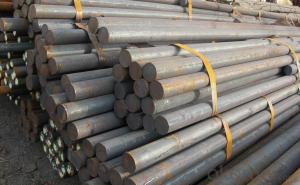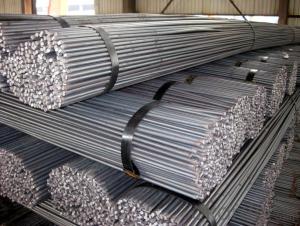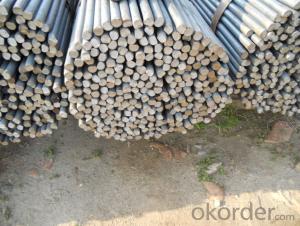GB 45#/SAE 1045 Steel Round Bar 16mm-18mm
- Loading Port:
- China main port
- Payment Terms:
- TT or LC
- Min Order Qty:
- 50 m.t
- Supply Capability:
- 10000 m.t/month
OKorder Service Pledge
OKorder Financial Service
You Might Also Like
GB 45#/SAE 1045 Steel Round Bar 16mm-18mm
Description:
-Specification: 16mm-18mm
-Length: 6m、12m
-Standard: GB/SAE/Japanese Standard
-Material: GB 45#/SAE1045/S45C
Chemical Composition of GB 45#/SAE 1045 Steel Round Bar 16mm-18mm:
| C | Si | Mn | P | S | Ni | Cr | Cu |
| 0.42-0.50 | 0.17-0.37 | 0.50-0.80 | ≤0.035 | ≤0.035 | ≤0.30 | ≤0.25 | ≤0.25 |
Packaging & Delivery of GB 45#/SAE 1045 Steel Round Bar 16mm-18mm:
Packaging Detail: All goods are packed in bundle with steel strips and shipped by break bulk vessel or container (depend on target market and different ports)
Delivery Detail: 45 days
MOQ: 50 tons per specification; we can negotiate the quantity if the specification is normal or we have stock of one specification.
Weight: The price invoicing on theoretical weight basis or actual weight basis depends on customer’s request.
Shipment: The shipment of bulk break or container is depends on customer’s request and the situation of the port of destination.
Documents given: Full set of original clean on board bill of lading; Original signed commercial invoice; Original packing list; Policy of insurance; Certificate of origin and what the target market needs.
Payment:
-Invoicing on theoretical weight or actual weight a s customer’s request.
-FOB, CFR or CIF.
-Regular terms of payment:
1, 30% payment in advance, the remaining balance (70% payment) against the copy of B/L.
2, 30% payment in advance, the remaining balance (70% L/C) against the copy of B/L.
3, Negotiable.
Images of GB 45#/SAE 1045 Steel Round Bar 16mm-18mm:
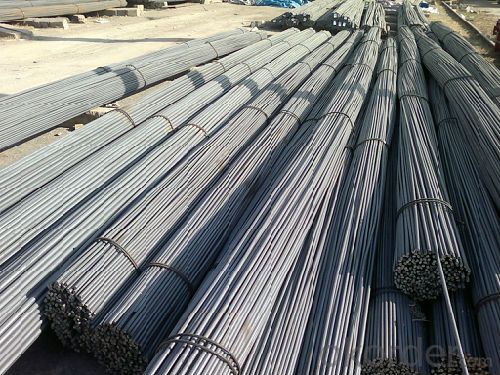
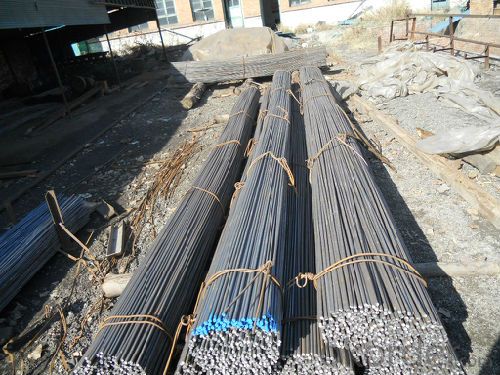
*If you would like to get our price, please inform us the size, standard/material and quantity. Thank you very much for your attention.
- Q:Is there a standard for the grounding of pumping units and the length of the length of the angle steel or round steel?
- What to play a few piles, with triangle connection, these seem to have some places have standards, but a place, a kind of, in general, general one is: ground wire pile to hit the moist soil layer, ensure the grounding reliable
- Q:What is the maximum length of a steel round bar?
- The length of a steel round bar can vary depending on several factors, including the bar's diameter, the manufacturing capabilities of the steel supplier, and transportation restrictions. Typically, steel round bars are made in standard lengths ranging from 6 to 12 meters (20 to 40 feet). However, it is possible to create longer bars through specialized processes or by combining multiple bars using welding techniques. In certain cases, it is possible to order custom-made steel round bars that exceed standard lengths, but this would necessitate making specific arrangements with the supplier and considering logistical and handling aspects during transportation. Ultimately, the maximum length of a steel round bar is determined by practical limitations and the specific requirements of the project or application.
- Q:Can steel round bars be used in the production of medical equipment?
- Medical equipment can indeed utilize steel round bars. This is because steel is a widely employed material in the production of medical devices and equipment. Its strength, durability, and versatility make it a popular choice. By utilizing steel round bars, one can fashion various components of medical equipment, including surgical instruments, orthopedic implants, diagnostic tools, and hospital furniture. Steel possesses desirable properties, such as resistance to corrosion and the ability to be sterilized, rendering it suitable for use in the medical sector where hygiene and patient safety are paramount. Furthermore, steel round bars can be easily machined and fabricated into different shapes and sizes, allowing for the customization of medical equipment to fulfill specific requirements.
- Q:What are the tolerances for steel round bars?
- The tolerances for steel round bars typically depend on the specific industry standards and customer requirements. However, common tolerances for steel round bars include variations in diameter, straightness, length, and surface finish. These tolerances ensure that the steel round bars meet the desired specifications and can be effectively used in various applications.
- Q:What are the different types of steel round bar surface finishes for improved lubricity?
- To enhance lubricity, there exists a variety of surface finishes for steel round bars. 1. Achieving a smooth finish involves employing grinding or polishing techniques to create a sleek surface. This reduces friction and serves as a solid foundation for applying lubricants. 2. Chrome plating entails electroplating a layer of chromium onto the round bar's surface. This results in a hard, smooth, and corrosion-resistant coat that offers exceptional lubricity. Chrome plating is frequently employed in applications necessitating low friction and wear resistance. 3. Nitriding, a surface hardening process, involves diffusing nitrogen into the round bar's surface. This generates a robust layer that amplifies the steel's lubricity. Nitriding is commonly utilized when high wear resistance and improved lubrication are imperative. 4. Black oxide, a chemical conversion coating, forms a black surface on the steel round bar. This finish provides a thin layer of protection against corrosion along with enhanced lubricity. Black oxide is frequently favored in applications that require lubricity without a decorative appearance. 5. Teflon coating, also known as PTFE (polytetrafluoroethylene) coating, involves applying a thin layer of Teflon onto the round bar's surface. This coating offers exceptional lubricity and low friction properties. Teflon coating is often employed in industries like food processing or packaging that necessitate non-stick properties. These examples showcase the various steel round bar surface finishes that can be utilized to enhance lubricity. The choice of finish depends on specific application requirements and the desired level of lubrication and wear resistance.
- Q:What is the difference between hot working and cold working of steel round bars?
- Hot working and cold working are two different methods used to shape and manipulate steel round bars. Hot working involves heating the steel to a high temperature, typically above its recrystallization temperature, and then shaping it through processes such as forging, rolling, or extrusion. This method helps to reduce the hardness and increase the ductility of the steel, making it easier to reshape and form into desired shapes. Hot working also helps to refine the grain structure of the steel, improving its mechanical properties. On the other hand, cold working is performed at or near room temperature without the need for heating the steel. It involves processes like cold rolling, drawing, or bending, where the steel is mechanically deformed to achieve the desired shape. Cold working increases the strength and hardness of the steel while reducing its ductility. It also causes strain hardening, which results in a finer grain structure and improved dimensional accuracy. In summary, the main difference between hot working and cold working of steel round bars lies in the temperature at which the processes are carried out and the resulting effects on the mechanical properties of the steel. Hot working is performed at high temperatures to increase ductility and refine grain structure, while cold working is done at or near room temperature to enhance strength, hardness, and dimensional accuracy.
- Q:Can steel round bars be cold worked?
- Yes, steel round bars can be cold worked. Cold working refers to the process of plastic deformation of a metal below its recrystallization temperature. This technique is commonly used to increase the strength and hardness of steel round bars. Cold working can be achieved through various methods such as cold rolling, cold drawing, or cold forging. These processes apply compressive forces to the steel, causing its shape to change without the need for heating. Cold working can result in improved mechanical properties, increased dimensional accuracy, and a smoother surface finish for steel round bars.
- Q:What is the difference between a turned and a polished steel round bar?
- The surface finishes and properties of a turned steel round bar and a polished steel round bar are different as a result of separate processes they undergo. Typically, a turned steel round bar is created by removing material from the surface of a steel bar using a lathe machine. This process involves rotating the bar against a cutting tool, which cuts away the outer layer, leaving a smooth and cylindrical surface. Although the turned bar may have visible machining marks, it is generally known for its precise and uniform diameter compared to other types of steel bars. Turned bars are commonly used in applications where dimensional accuracy is crucial, such as in machinery or tooling. On the other hand, a polished steel round bar goes through a different process involving grinding or buffing the surface to achieve a smooth and reflective finish. Polishing eliminates any imperfections or roughness, resulting in a highly lustrous appearance. Polished bars are often utilized in decorative applications or where visual aesthetics play a significant role, such as in architectural designs or high-end consumer products. To summarize, the main distinction between a turned and a polished steel round bar lies in their manufacturing processes and resulting surface finishes. A turned bar is machined to achieve precise dimensions, while a polished bar undergoes a polishing process to obtain a smooth and reflective surface. The choice between the two depends on the specific requirements of the application, with turned bars being preferred for dimensional accuracy and polished bars for aesthetic appeal.
- Q:What are the different grades of heat-treated steel round bars?
- The different grades of heat-treated steel round bars include, but are not limited to, AISI 4140, AISI 4340, AISI 8620, and ASTM A105.
- Q:What are the different joining methods for steel round bars?
- There are several different joining methods that can be used for steel round bars, depending on the specific application and desired outcome. Some of the most common joining methods for steel round bars include welding, brazing, and mechanical joining. 1. Welding: Welding is a popular method for joining steel round bars. It involves melting the edges of the bars and fusing them together using heat. Various welding techniques such as arc welding, MIG welding, TIG welding, and spot welding can be used, depending on the thickness and type of steel being joined. Welding provides a strong and permanent bond, making it suitable for heavy-duty applications. 2. Brazing: Brazing is another method used to join steel round bars. It involves heating the bars and melting a filler metal that has a lower melting point than the steel. The molten filler metal is then drawn into the joint by capillary action, creating a strong bond when it solidifies. Brazing is often used when the base metals have different melting points or when a lower-temperature joining process is required. 3. Mechanical joining: Mechanical joining methods do not involve any heat or melting of the steel round bars. Instead, they rely on mechanical means to hold the bars together. Examples of mechanical joining methods include bolted connections, riveting, and clamping. These methods are often used when disassembly or adjustability is required, as they provide a non-permanent joint that can be easily undone. It is important to consider factors such as the strength requirements, environmental conditions, and the specific application when choosing a joining method for steel round bars. Each method has its own advantages and limitations, and the appropriate joining method should be selected to ensure a secure and durable bond between the round bars.
1. Manufacturer Overview |
|
|---|---|
| Location | |
| Year Established | |
| Annual Output Value | |
| Main Markets | |
| Company Certifications | |
2. Manufacturer Certificates |
|
|---|---|
| a) Certification Name | |
| Range | |
| Reference | |
| Validity Period | |
3. Manufacturer Capability |
|
|---|---|
| a)Trade Capacity | |
| Nearest Port | |
| Export Percentage | |
| No.of Employees in Trade Department | |
| Language Spoken: | |
| b)Factory Information | |
| Factory Size: | |
| No. of Production Lines | |
| Contract Manufacturing | |
| Product Price Range | |
Send your message to us
GB 45#/SAE 1045 Steel Round Bar 16mm-18mm
- Loading Port:
- China main port
- Payment Terms:
- TT or LC
- Min Order Qty:
- 50 m.t
- Supply Capability:
- 10000 m.t/month
OKorder Service Pledge
OKorder Financial Service
Similar products
New products
Hot products
Related keywords
